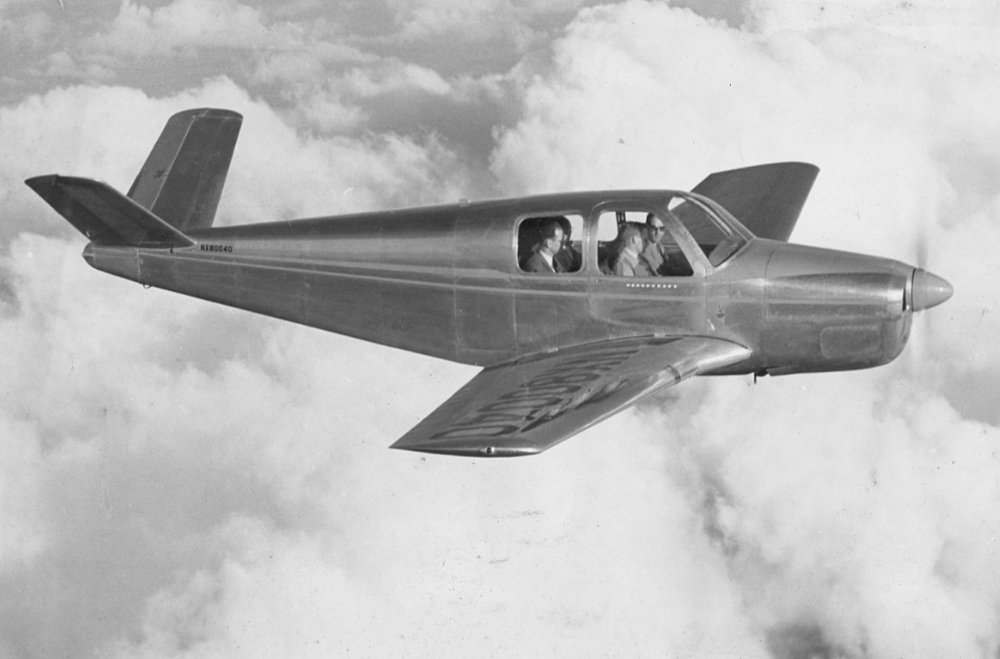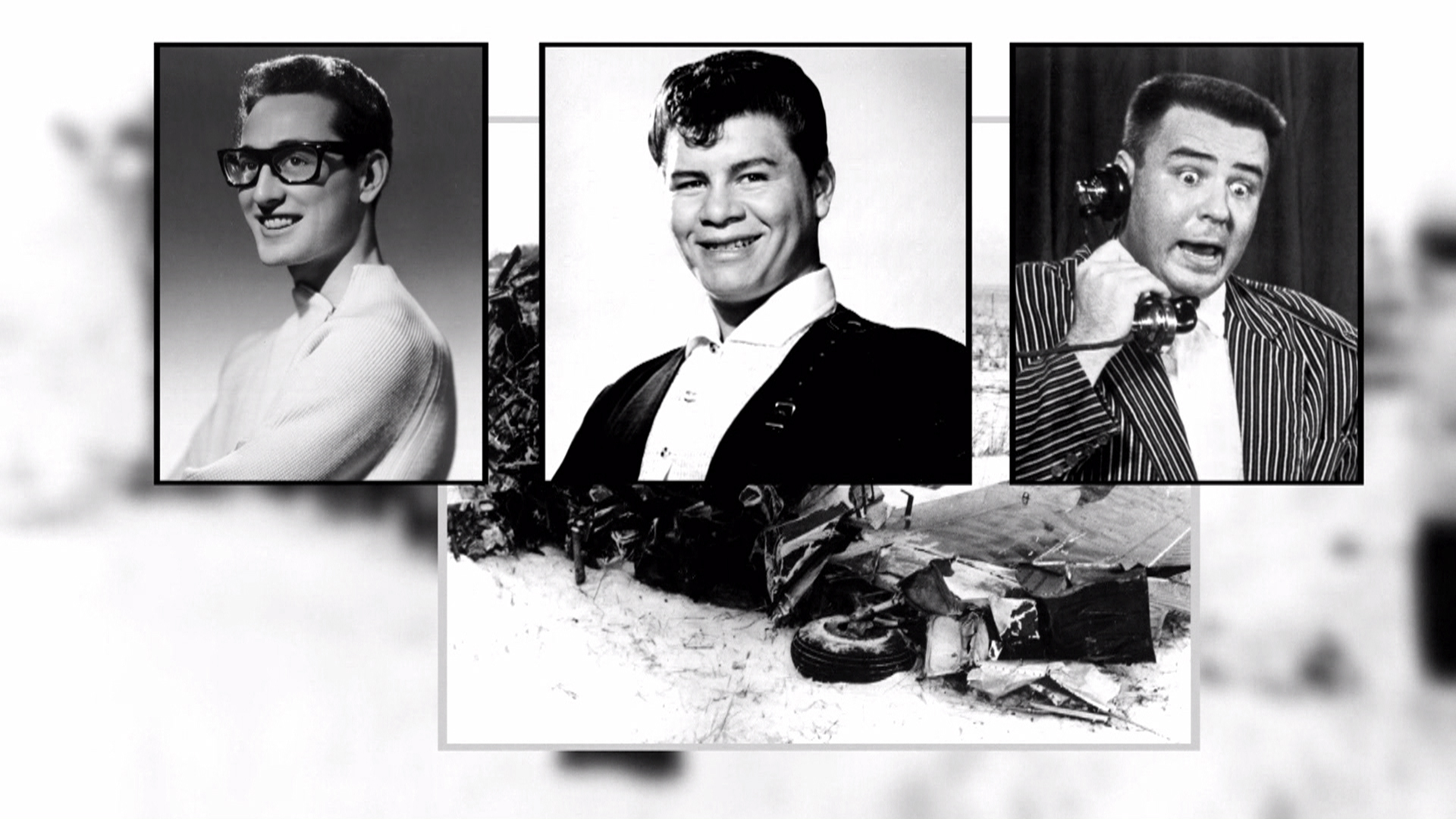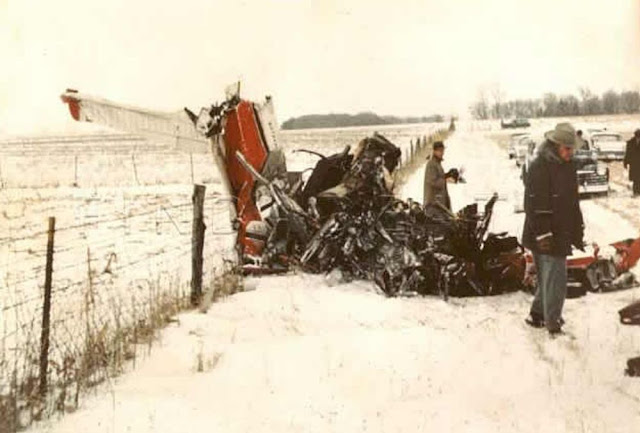The Day The Music Died - The Buddy Holly, Ritchie Valens, Big Bopper Plane Crash

|

|

|
Narrative: Pilot mistakes were behind the tragedy known as the day the music died. That was the day that Buddy Holly, Ritchie Valens, and JP "The Big Bopper" died in a tragic plane crash shortly after takeoff.
In November 1958, Buddy Holly terminated his association with The Crickets. According to Paul Anka, Holly realized he needed to go back on tour again for two reasons: he needed cash because the
Crickets' manager Norman Petty had apparently stolen money from him, and he wanted to raise funds to move to New York City to live with his new wife, María Elena Holly, who was pregnant.[3]
Holly signed up with General Artists Corporation (GAC) because "he knew they were planning a British tour and he wanted to be in on that".[4]
For the start of the "Winter Dance Party" tour, Holly assembled a band consisting of Waylon Jennings (bass), Tommy Allsup (guitar), and Carl Bunch (drums), with the opening vocals of Frankie Sardo.
The tour was set to cover twenty-four Midwestern cities in as many days—there were no off days. New hit artist Ritchie Valens, "The Big Bopper" J. P. Richardson, and the vocal group Dion and the
Belmonts joined the tour to promote their recordings and make an extra profit.[5][6]
Winter Dance Party Tour schedule, 1959
The 1959 tour began in Milwaukee, Wisconsin, on January 23, with the performance in Clear Lake, Iowa, on February 2 being the eleventh of the twenty-four scheduled events. The amount of
travel required soon became a serious problem. The distances between venues had not been properly considered when the performances were scheduled. Instead of systematically circling around
the Midwest through a series of venues in close proximity to one another, the tour erratically zigzagged back and forth across the region, with distances between some tour stops exceeding 400
miles (640 km). As there were no off days, the bands had to travel most of each day, frequently for ten to twelve hours in freezing mid-winter temperatures. Most of the Interstate Highway System
had not yet been built, so the routes between tour stops required far more driving time on narrow two-lane rural highways than would now be the case on modern expressways.
GAC-Super Productions, the organization that booked the tour,[7] received considerable criticism for their seemingly total disregard for the conditions they forced the touring musicians to endure:
They didn't care. It was like they threw darts at a map ... The tour from hell—that's what they named it—and it's not a bad name.
—Buddy Holly historian Bill Griggs[8]
The entire company of musicians traveled together in one bus, although the buses used for the tour were wholly inadequate, breaking down and being replaced frequently. Griggs estimates that five
separate buses were used in the first eleven days of the tour—"reconditioned school buses, not good enough for school kids".[8] The artists themselves were responsible for loading and unloading
equipment at each stop, as no road crew assisted them. Adding to the disarray, the buses were not equipped for the harsh weather, which consisted of waist-deep snow in several areas and varying
temperatures from 20 °F (−7 °C) to as low as −36 °F (−38 °C). One bus had a heating system that malfunctioned shortly after the tour began, in Appleton, Wisconsin.
Richardson and Valens began experiencing flu-like symptoms and drummer Bunch was hospitalized for severely frostbitten feet after the tour bus stalled in the middle of the highway in subzero
temperatures near Ironwood, Michigan. The musicians replaced that bus with another school bus and kept traveling.[9] As Holly's group had been the backing band for all of the acts, Holly, Valens
and DiMucci took turns playing drums for each other at the performances in Green Bay, Wisconsin, and Clear Lake, Iowa, with Holly playing drums for Dion, Dion playing drums for Ritchie, and Ritchie
playing drums for Holly.[10]
On Monday, February 2, the tour arrived in Clear Lake, west of Mason City, having driven 350 miles (560 km) from the previous day's concert in Green Bay, Wisconsin. The town in northern Iowa had
not been a scheduled stop; tour promoters hoped to fill the open date and called the manager of the local Surf Ballroom, Carroll Anderson (1920–2006), and offered him the show. Anderson accepted
and they set the show for that night. By the time Holly arrived at the venue that evening, he was frustrated with the ongoing problems with the bus. The next scheduled destination after Clear Lake
was Moorhead, Minnesota, a 365-mile (590 km) drive north-northwest—and, as a reflection of the poor quality of the tour planning, a journey that would have taken them directly back through the two
towns they had already played within the last week. No let-up after that was in sight, as the following day after having traveled from Iowa to Minnesota, they were scheduled to travel right back to
Iowa, specifically almost directly south to Sioux City, a 325-mile (520 km) trip.
Holly chartered a plane to fly himself and his band to Fargo, North Dakota, which is adjacent to Moorhead. The rest of the party would have picked him up in Moorhead, saving him the journey in the
bus and leaving him time to get some rest.[9] Their gig in Moorhead was to have been a radio performance at the station KFGO with disk jockey Charlie Boone.
After the show ended, Anderson drove Holly, Valens, and Richardson to nearby Mason City Municipal Airport,[19] where the elevation is 1,214 feet (370 m) AMSL. The weather at the time of departure
was reported as light snow, a ceiling of 3,000 feet (900 m) AMSL with sky obscured, visibility six miles (10 km), and winds from 20 to 30 mph (8.9 to 13.4 m/s). Although deteriorating weather was
reported along the planned route, the weather briefings Peterson received failed to relay the information.[20]
The plane took off normally from runway 17 (today's runway 18) at 00:55 (12:55 am) CST on Tuesday, February 3.[21] Hubert Jerry Dwyer, owner of the flying service, watched the southbound take-off
from a platform outside the control tower. He was able to clearly see the aircraft's tail light for most of the brief flight, which started with an initial 180 degree left turn to pass east of the
airport, climbing to approximately 800 feet (240 m) AGL. After an additional left turn to a northwesterly heading, the tail light was observed gradually descending until it disappeared. Around 1 am,
when Peterson failed to make the expected radio contact, repeated attempts were made to establish radio contact, without success.[12]
Later that morning, Dwyer retraced Peterson's planned route by air, and around 9:35 am spotted the wreckage less than six miles (10 km) northwest of the airport.[12]
The Bonanza had impacted terrain at high speed, estimated to have been around 170 mph (270 km/h), banked 90° to the right and in a nose-down attitude. The right wing tip struck the ground first,
gouging a 12'x2' deep furrow, crumpling then breaking off. The fuselage then hit the ground right-side down and bounced a few feet back into the air, traveling another 50 feet through the air,
simultaneously rolling inverted due to the remaining left wing still generating lift. The plane struck the ground a final time, in an inverted, nose-down position, the nose hitting and flipping
the plane over into a right-side up, tail-first position. The momentum of the heavy engine caused the fuselage, left wing remaining attached and intact to the end, to roll upon itself into a virtual
ball, rolling nose-over-tail across the frozen field for 540 feet (160 m), before coming to rest tail-first against a wire fence.[12] The bodies of the performers had been ejected from the fuselage
and lay near the plane's wreckage, while Peterson's body, which was entangled in the wreckage, could only be retrieved after the cockpit was cut open using blowtorches.[12][22] With the rest of the
entourage en route to Minnesota, Anderson, who had driven the party to the airport and witnessed the plane's takeoff, had to identify the bodies of the musicians.[23] The county coroner, Ralph Smiley,
reported that all four victims died instantly, the cause of death being "gross trauma to brain" for the three musicians and "brain damage" for the pilot.[24][25]
replace the 30-year-old plane, which all in the band's circle agreed was well past its prime.
Pilot Debrief: Pilot mistakes were behind the tragedy known as the day the music died.
Flight Information
Our flight plan will take us on the final "Tour from Hell", as the artists referred to it. Unlike the actual tour, we will fly from city to city while they went by bus most of the time.
You will need to check safe flight altitude because the final, ill-fated flight, was a VFR 3000 ft flight plan to stay under the clouds. Also ensure that your plane can handle the various
airport size, but aircraft similar to the Beech 35 v-tail should work for all the legs of this tour.
Flight Plan: KMKE DCT KENW DCT KMKT DCT KEAU DCT KMVE DCT KSTP DCT KFOD DCT KDLH DCT KGRB DCT KMCW DCT KFAR
Flight Route: Same
Description:
Suggested flight altitude of 3000 feet for the planned altitude of the final flight (KMCW to KFAR). Weather:
Snow, winds NNW 25 gusting 45, 1:00 am flight time
| Flight Code | Origin | Destination | Distance(NM) | Orig Airport | Dest Airport |
| 903081 | KMKE | KENW | 21.1 | Gen Mitchel Intl | Kenosha Rgl |
| 903082 | KENW | KMKT | 278.7 | Kenosha Rgl | Mankato Rgl |
| 903083 | KMKT | KEAU | 111 | Mankato Rgl | Chippewa Rgl |
| 903084 | KEAU | KMVE | 179.7 | Chippewa Rgl | Montevideo-Chippewa Co |
| 903085 | KMVE | KSTP | 112.5 | Montevideo-Chippewa Co | St. Paul Holman |
| 903086 | KSTP | KFOD | 151.2 | St. Paul Holman | Ft Dodge Rgl |
| 903087 | KFOD | KDLH | 271.2 | Ft Dodge Rgl | Duluth Intl |
| 903088 | KDLH | KGRB | 221.4 | Duluth Intl | Green Bay Intl |
| 903089 | KGRB | KMCW | 238.8 | Green Bay Intl | Mason City Mun |
| 903090 | KMCW | KFAR | 269.8 | Mason City Mun | Hector Intl |